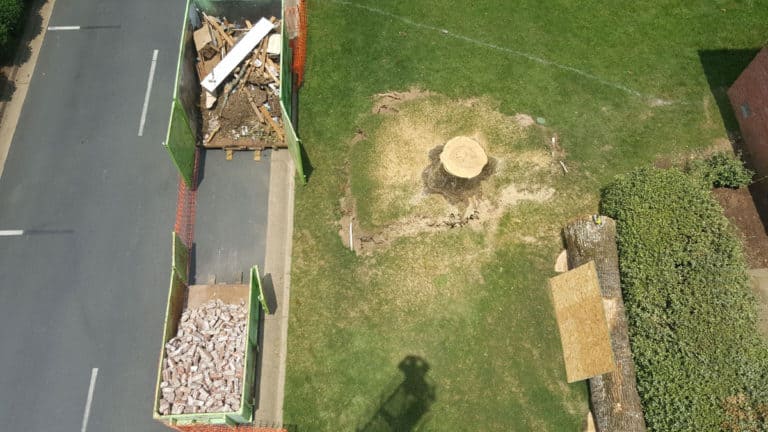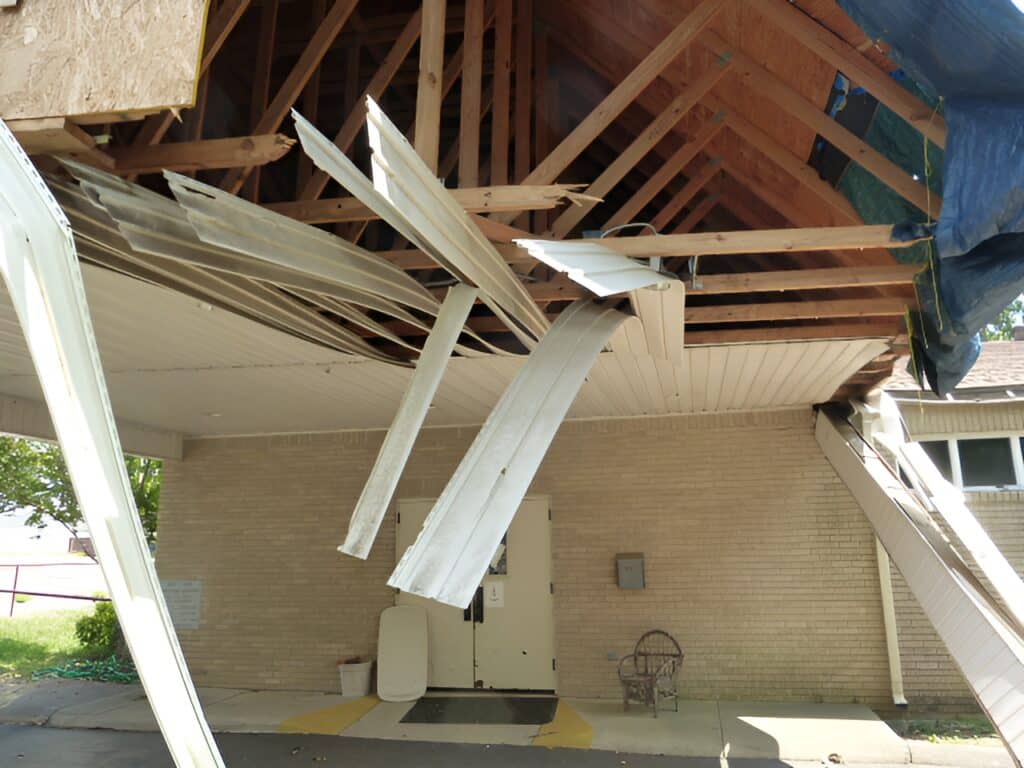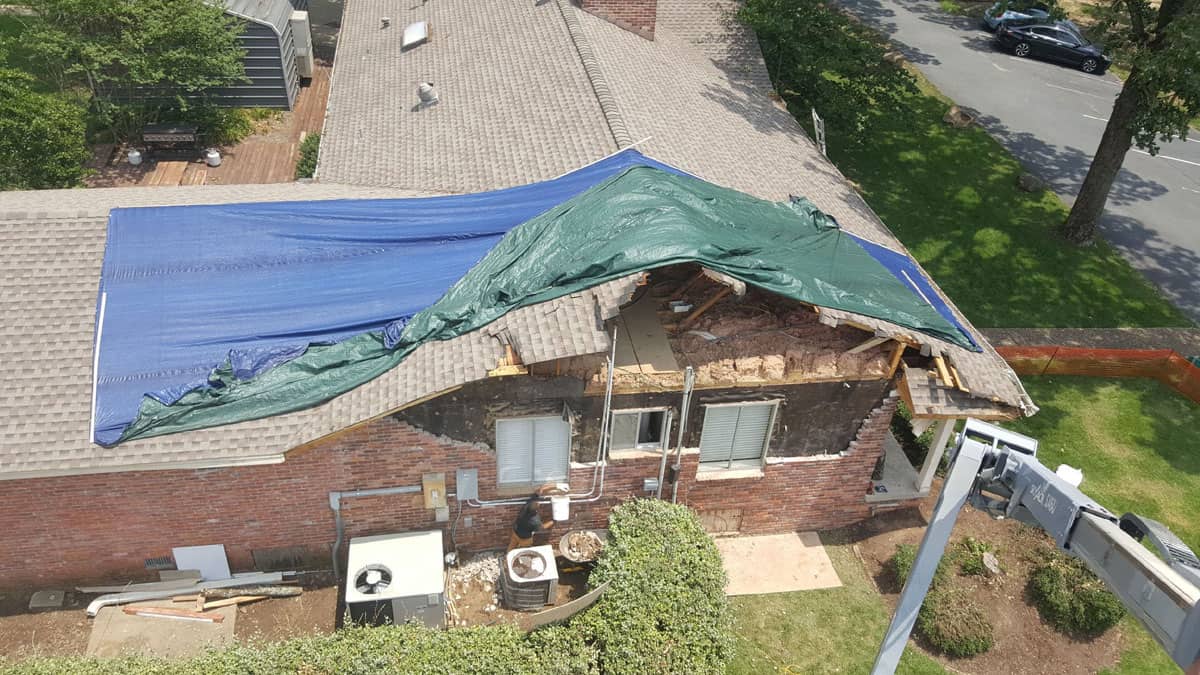Contact Us Today!
Wind Damage?
If your commercial or residential property experiences winds over 45 miles per hour, you should inspect it as soon as it is safe to do so. Winds of that speed – especially straight-line winds – can damage windows, doors, roofs, and more. If you discover damage to your property in the aftermath of a wind event, you should immediately call a trusted wind damage restoration expert to mitigate the problem. As a locally owned and operated company, Pro Service Builders is at the ready, 24/7, to help you handle any structural concerns due to wind damage.

Why Choose Us?
At Pro Service Builders, we have built our reputation on expert, attentive, and speedy restoration and mitigation work. Since 2014, we’ve thrived on helping our neighbors here in Little Rock and the surrounding communities recover from all manner of disasters, including wind damage. We offer a 24/7 emergency response so that you’re never left stranded.
And we take pride in our work. Our goal is to leave every building we touch – whether residential or commercial – in better shape than before the damage occurred. We also respect the difficulty of dealing with damage and insurance claims, so we go the extra mile to relieve any stress you may be feeling. The result is peace of mind and confidence as you move forward.
How Common is Wind Damage?
Wind damage is far more common than you think. When we say “wind damage” we’re not referring to damage from a tornado. In fact, the phrase “damaging winds” should not be used in conjunction with a tornado or hurricane. Those types of storms have their own categories of winds. But once winds reach speeds of 30-45 mph, they’re considered dangerous. And an Arkansas summer storm can easily reach that level. So, any time we experience sustained gusts of those speeds, there is a chance for residential or commercial property damage.

We’re Here to Help
When it comes to wind damage, it’s critical to act quickly. Pro Service Builders is ready to help as soon as you need us! Our team is standing by, 24/7, to answer your call. A speedy response can prevent further damage to your property. For instance, if wind sends a branch through your window or rips a hole in your roof, you could face water damage as well if additional storms are in the forecast. Therefore, it is imperative to act quickly to help minimize additional damage and expenses.
Have an Emergency? Contact us Today!
24/7 Emergency Response
100-plus years combined experience
Fully Bonded and Insured
5-star Rating
Wind Damage 101
As we’ve mentioned before, “damaging winds” are not necessarily synonymous with tornado or hurricane activity. Instead, “damaging winds” can be applied any time there are average wind speeds above 50-60 miles per hour. Winds of this speed can do plenty of damage, including tearing shingles off roofs, peeling siding away from structures, and even uprooting trees. And thanks to years of experience, we’ve learned to be on the lookout for several factors.
- Straight-Line Winds and Derechos
- How Damaging Are Straight-Line Winds?
- When Should I Be Aware of Storm Winds
- What to Avoid in a Water Damage Situation
Straight-Line Winds and Derechos Wind isn’t just wind. In fact, there are different types and different names for a wide variety of winds. These were created to help differentiate damage that occurs from tornados and hurricanes versus other types of storms.
The most dangerous of these non-tornado/hurricane winds are typically “straight-line” winds. Straight-line winds typically occur during a thunderstorm – usually during a specific kind of thunderstorm called “derecho.”
“Derechos” are fast-moving bands of thunderstorms that produce winds that move horizontally along the ground: Straight-line winds. These winds occur due to thunderstorm downdrafts. Meanwhile, winds produced by tornadoes and hurricanes, while extraordinarily powerful, swirl and change direction.
Wind isn’t just wind. In fact, there are different types and different names for a wide variety of winds. These were created to help differentiate damage that occurs from tornados and hurricanes versus other types of storms.
The most dangerous of these non-tornado/hurricane winds are typically “straight-line” winds. Straight-line winds typically occur during a thunderstorm – usually during a specific kind of thunderstorm called “derecho.”
“Derechos” are fast-moving bands of thunderstorms that produce winds that move horizontally along the ground: Straight-line winds. These winds occur due to thunderstorm downdrafts. Meanwhile, winds produced by tornadoes and hurricanes, while extraordinarily powerful, swirl and change direction.
How Damaging Are Straight-Line Winds? Because they are more frequent than tornadoes or hurricanes, straight-line winds are responsible for much more damage than either of those two more well-known disasters. Straight-line winds have even been measured at 100 mph – a small tornado may only reach speeds of 74 mph. So, you can see how damaging that might be to any residential or commercial structure in its path.
Because they are more frequent than tornadoes or hurricanes, straight-line winds are responsible for much more damage than either of those two more well-known disasters. Straight-line winds have even been measured at 100 mph – a small tornado may only reach speeds of 74 mph. So, you can see how damaging that might be to any residential or commercial structure in its path.
When Should I Be Aware of Storm Winds Winds that reach 39-46 mph can break small branches off trees (and send them flying into your property). Winds between 47-54 mph can start damaging buildings (such as roofing shingles and tiles) and breaking larger branches. Winds of 55-63 mph can do structural damage to roofs and uproot small trees. Winds of 64-75 mph can take down larger trees. Winds above 75 mph carry a severe risk of heavy damage and can even overturn small mobile homes.
Winds that reach 39-46 mph can break small branches off trees (and send them flying into your property). Winds between 47-54 mph can start damaging buildings (such as roofing shingles and tiles) and breaking larger branches. Winds of 55-63 mph can do structural damage to roofs and uproot small trees. Winds of 64-75 mph can take down larger trees. Winds above 75 mph carry a severe risk of heavy damage and can even overturn small mobile homes.
What to Avoid in a Water Damage Situation When it comes to water damage, the cleaning and restoration process is usually better left to professionals. Water easily hides in walls, flooring, and other building materials. It can be corrosive, and the true extent of the water damage might not be visible without the right tools and knowledge.
Never enter a room with standing water until the electricity is turned off. Also, avoid handling damaged wiring or appliances. You should also not use electrical appliances that are standing on wet or damp flooring, as they also pose a risk of fire or electrical shock.
Never use a regular household vacuum cleaner to remove water. Our restoration team uses specialized vacuums that safely and more thoroughly remove standing water.
Be very careful not to disturb any visible mold. Mold spores and other allergens can travel long distances in the air and settle around your home. If that happens, it can lead to health issues and future mold problems. It’s better to leave the area and wait for our cleaning team to remove the mold safely.
It’s best to leave any books in a water-damaged room on their shelves. Keeping books packed tightly on shelves helps with the restoration process.
When it comes to water damage, the cleaning and restoration process is usually better left to professionals. Water easily hides in walls, flooring, and other building materials. It can be corrosive, and the true extent of the water damage might not be visible without the right tools and knowledge.
Never enter a room with standing water until the electricity is turned off. Also, avoid handling damaged wiring or appliances. You should also not use electrical appliances that are standing on wet or damp flooring, as they also pose a risk of fire or electrical shock.
Never use a regular household vacuum cleaner to remove water. Our restoration team uses specialized vacuums that safely and more thoroughly remove standing water.
Be very careful not to disturb any visible mold. Mold spores and other allergens can travel long distances in the air and settle around your home. If that happens, it can lead to health issues and future mold problems. It’s better to leave the area and wait for our cleaning team to remove the mold safely.
It’s best to leave any books in a water-damaged room on their shelves. Keeping books packed tightly on shelves helps with the restoration process.
Have Questions?
Answers to Frequently Asked Questions
When it comes to wind damage, we know you’ll have lots of questions. That’s why we take our time to talk with you and explain everything in detail. Some of the most consistent questions our experts encounter include:
A building’s roof takes the most stress under high winds. Damaging winds can rip up commercial roofing, shingles and tiles or send debris crashing into the roof. So, check your roof after any strong storm, because even minor damage to your roof can lead to bigger problems if left unattended. If possible, aim to have your roof inspected once a year regardless of its age.
Keep your property neat and make sure lighter objects are inside or anchored. Strong winds can pick up tools, trash cans, plant pots, etc., and hurl them at your house. These objects become dangerous projectiles under damaging winds. Also, keep on top of your landscaping. Trim trees, take away and dispose of debris regularly.
We’ve already mentioned roofs, but garage doors are also particularly susceptible to damaging winds. Consider the damage wind could do if just one garage door was removed in a commercial garage. If you can, brace the back of the door or buy a stronger door and track system.

